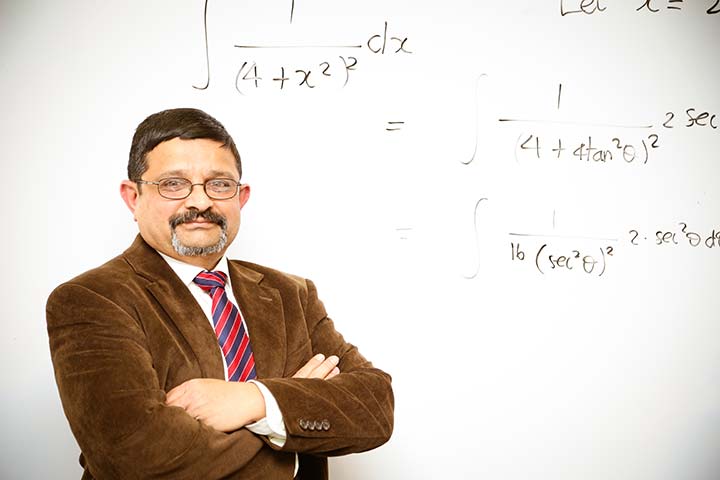by Giovanni Amado-Sanchez, 2017 Public Relations Intern
Somewhere along the mile walk between his house and a private school where he studied in the city of Chennai, Tamil Nadu, India, a 10-year-old boy walks pensively while computing the product of two three-digit numbers in his head in order to keep occupied. Inspired by his next-door neighbor and high school mathematics teacher, the boy develops a foundation for his ability to understand mathematics with every number carried over in his multiplications.
At age seven, he began wearing glasses and became the recipient of “professor, professor!” calls among his family. He preferred physics to mathematics, so becoming a professor of mathematics was not his primary intention, although he has continuously loved explaining things all of his life. In India, the education placement system directed him toward a mathematics vocation, and his course was set. He earned a Bachelor of Science degree in Mathematics from Vivekananda College in Chennai, India, and a Master of Science degree in Mathematics from the Indian Institute of Technology in Kanpur, India. Eventually, he completed his Ph.D. in Mathematics (researching non-commutative ring theory) at Syracuse University in New York, thereby earning the moniker Dr. Murali Ranganathan.
Dr. Ranganathan received a call about a teaching position in January 1991 from Barton College, which confused him. He had not applied for a position at Barton. Immediately, the Academic Dean of the College informed Dr. Ranganathan that he had indeed applied for a position at the college, but the college had just changed its name from “Atlantic Christian College.” Twenty-six years later, Dr. Ranganathan is still explaining logarithms and differential equations to students, and he is always willing to take on extra tasks when they benefit students, colleagues, or the mathematics program. For example, he taught six extra credit hours last semester in order to learn more about the evolving College Algebra course. Nonetheless, he shares that his interactions with students, colleagues, and people in general provide the reason for his being here.
“People need to understand that when a professor interacts with students it is not only the student learning from the professor but also the professor learning so much from the student,” Dr. Ranganathan explains. “For example, having worked one-on-one with a legally blind student, I came away learning more because of the specific challenges that she faced in learning math. This gave me the opportunity to think about how I could teach math so that a person who could not see could still learn mathematics and appreciate its value. That is what drives me and makes my job enjoyable.”
Dr. Ranganathan describes himself as an “encouraging, pushing, knowledgeable, fair, and balanced” professor. More importantly, he considers himself empathetic to students who struggle in mathematics. This empathy is born from his understanding that learning does not have limits. “Education does not stop in the classroom; it’s a lifelong process,” he notes. “A few years ago, I took a pottery class with Mark Gordon. I just wanted to be a student and do something that I knew nothing about. This type of experience gives me the opportunity to empathize with students who have great difficulty doing mathematics, because I still cannot throw a bowl on a wheel correctly. I do things every now and then to keep reminding myself what it is like to be challenged in an area that is not one’s ‘cup of tea.’”
This compassionate mathematics professor enjoys working in the garden with his wife, Vandana Srivastava, as well as working with his hands, such as investigating electrical work and plumbing. However, his favorite activities are reading and traveling. He enjoys reading fiction and murder mysteries, and he has traveled to four of the seven continents. His favorite book is “When Breath Becomes Air” by Paul Kalanithi. And, having visited nearly every crowded city in the world, his favorites are Venice, Italy, and Cairo, Egypt. Despite his love for the famous and crowded cities of the world, Dr. Ranganathan says that he appreciates nature even more.
“As a young man I was an avid mountaineer,” Dr. Ranganathan shares. “So, nature has always been more inviting to me than a concrete jungle. I can still vividly remember the moments I spent 17,000 feet high in the Himalayas, where I didn’t have a soul to ask what or how I was doing, but, at the same time, I didn’t need a soul to ask me anything. The silence was both deafening and calming.”
Dr. Ranganathan would like to visit the remaining continents to complete his “travel bucket list” of all seven. And, his ultimate traveling dream is to visit the frozen land of Antarctica. For now though, Dr. Ranganathan can be found in Moye Science Hall empathetically teaching students and computing the product of two three-digit numbers in his head to keep occupied.
END


